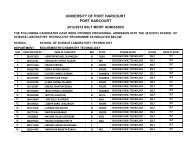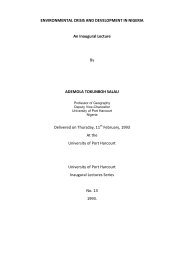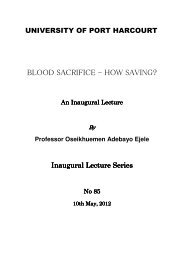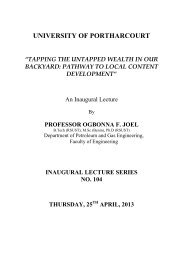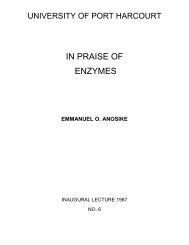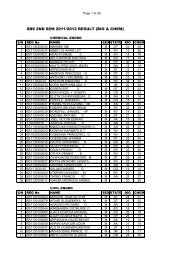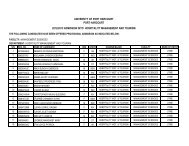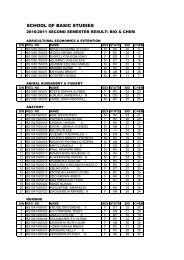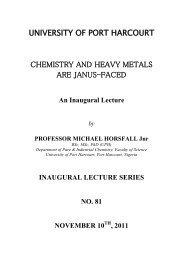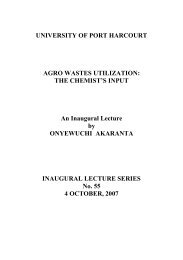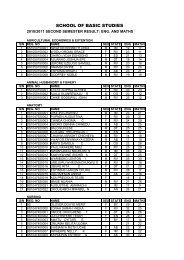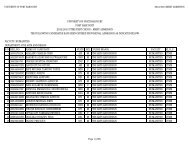93rd Inaugural Lecture - 2012 by Prof. O. A. Georgewill
93rd Inaugural Lecture - 2012 by Prof. O. A. Georgewill
93rd Inaugural Lecture - 2012 by Prof. O. A. Georgewill
- No tags were found...
Create successful ePaper yourself
Turn your PDF publications into a flip-book with our unique Google optimized e-Paper software.
UNIVERSITY OF PORT HARCOURTCRUDE OIL: SWEET AND SOUR-EFFORTS AT MITIGATING THETOXIC EFFECTSAn <strong>Inaugural</strong> <strong>Lecture</strong>ByPROF. OWUNARI ABRAHAM GEORGEWILLB. Med Sc. (Hons) Pharmacology, MBBS, MSc. Pharmacology, MD, (UPH)Department of Pharmacology, Faculty of Basic Medical Sciences,College of Health SciencesINAUGURAL LECTURE SERIESNO. 9313 TH SEPTEMBER, <strong>2012</strong>i
DEDICATIONWith humility I dedicate this lecture to;1. My mentor, teacher and academic father Late <strong>Prof</strong>. R. N. P.Nwankwoala.2. My mother Late Mrs. Ineyi A. <strong>Georgewill</strong> and mygrandmother Late Mrs. Laura M. Oribu3. My lovely wife Dr. (Mrs.) Udeme O. <strong>Georgewill</strong> and mychildren Barrister Melford, Miss Tamunoemi, MissTamunodein and Miss Tamunobakam.4. My beloved twin brother, Hon Justice Biobele A. <strong>Georgewill</strong>and his family.ii
ACKNOWLEDGEMENTI wish to express with reverence my utmost gratitude to God. Hefrom whom all goodness flows, for everything I am today and foreverything I will be tomorrow, to Him be all the glory, honour andadoration, for without Him, I am nothing.I lack words enough to thank my mother, Mrs. Ineyi A. <strong>Georgewill</strong>and my maternal grandmother Mrs. Laura M. Oribu both ofblessed memory for all their love, care and sacrifices for me andmy twin after the cold hands of death snatched away our fatherwhen we were just one year old. They toiled, sold their belongings,wrappers and all they had to give us a sound education, may theirbeautiful souls continue to rest in peace. To my father Mr.Abraham O. <strong>Georgewill</strong>, I say thank you for bringing me into theworld, though I did not know you well enough, may you continueto rest from your labours.My lovely and beloved wife Dr. (Mrs) Udeme O. <strong>Georgewill</strong> andmy children Barrister Melford, Miss Tamunoemi, MissTamunodein and Miss Tamunobakam, I appreciate you all forbeing there for me through thick and thin. I cherish you all verygreatly for all your tremendous support and stability at the homefront. My wife, I thank you also for being a dependable researchpartner. God bless you all.My beloved Twin brother Hon. Justice Biobele A. <strong>Georgewill</strong>, myinseperable twin, for 47 years, no day has passed without ouriii
talking to each other, without our caring for each other. I amindeed grateful to God for making you my Twin brother. I cannotthank you enough for all we have been to each other. God blessand keep you always. God bless and keep your lovely wife DameFunmilayo B. <strong>Georgewill</strong> and your children, Faustinah, Lolia, Ellaand Princess. My siblings,Dr. Dawaye A. <strong>Georgewill</strong>/family, Mr. Opu A. <strong>Georgewill</strong>/family,Madam Abrahamba <strong>Georgewill</strong>/family, Hon. Oribi/family andIjuba. I remain ever grateful for all your love and care. My uncles,Chief Walter O. A Akpana, <strong>Prof</strong>. R.S Oruamabo, <strong>Prof</strong>. K. A.Harrison, High Chief & Pastor (Mrs) O. B. Lulu-Briggs, Chief AsaraA. Asara, Chief A. G. Oweredaba. I appreciate all yourencouragement in my career and life struggles. My parents- in- lawDr. & Mrs. Dominic Peter Uyanga and family I thank you for allyou have done for me since our paths crossed each other.I acknowledge with gratitude all my teachers from primary schoolthrough my university education for turning me from nothing tosomething, for all your commitment to making me a good doctor,a good teacher, a good researcher, a good administrator, I remaineternally grateful to you all. I remember and appreciate with tearsin my eyes, my teacher, my mentor, my academic father <strong>Prof</strong>.Reginald Nwairegbu Pawa Nwankwoala of blessed memorywithout whom I would not have taken a career in Pharmacologyand would not have been a <strong>Prof</strong>essor of Pharmacology and wouldnot be giving a lecture on Pharmacology. You loved me, cared forme, you tutored me, you taught me how to teach, you taught mehow to carry out research, you taught me how to develop aiv
esearch mind, to you I remain eternally grateful for making mewho I am today.Let me also appreciate my colleagues and staff in the Departmentof Pharmacology, Faculty of Basic Medical Sciences, College ofHealth Sciences, University of Port Harcourt and the Niger DeltaUniversity for all your support and encouragement in my career;<strong>Prof</strong>. Nimi D. Briggs, <strong>Prof</strong>. Don Baridam, <strong>Prof</strong> J. A. Ajienka, <strong>Prof</strong>.Chris Akani, <strong>Prof</strong>. Nelson Brambaifa, <strong>Prof</strong>. (Mrs) O. O. Ebong,<strong>Prof</strong>. A. W. Obianime, <strong>Prof</strong>. Hope Obianwu, <strong>Prof</strong>. Obodo, <strong>Prof</strong>.Didia, <strong>Prof</strong>. Prince Unekwe, <strong>Prof</strong>. I. M. Siminialayi, <strong>Prof</strong>. Ogoni,Acting VC, Niger Delta University, <strong>Prof</strong>. Chris Ikporukpo, <strong>Prof</strong>. R.Konya, <strong>Prof</strong>. Bene Willie Abbey, <strong>Prof</strong>. H. Fawehinmi, <strong>Prof</strong>. Nwafor,<strong>Prof</strong>. D. V. Dapper, Dr (Mrs.) U.O.<strong>Georgewill</strong>, Dr. H.Kagbo, Dr. J.Aprioku, Dr. Eyaru, Dr. Joachim Odigie, Mrs. Ekine, Mrs. MathildaDeekor, Joshua Isirima, Charity Jones, chief Daniel Nsane,Tubobelem, Kabari, Biiragbara, Michael, Mina and Mathilda. I amindeed very grateful to you all.To all my students (Undergraduate and Post Graduate), past andpresent, I thank you.Let me specifically thank Hon. Justice Biobele A. <strong>Georgewill</strong>, Dr(Mrs) Udeme O. <strong>Georgewill</strong>, Barrister Melford O. <strong>Georgewill</strong> andMr. Mr. Williams Wordi for proof reading this lecture.I have saved the best for the concluding segment of myappreciation, let me whole heartedly and with utmost joy, thankthe Vice Chancellor <strong>Prof</strong>. Joseph Atubokiki Ajienka for giving methis opportunity to stand before you all to deliver my inaugurallecture, Sir, I appreciate you greatly for providing the enablingv
environment for research to thrive in this university. Registrar,Ma, Mrs. Mathilda Nnodim, I appreciate you for your support. Tothe Principal Officers, Provost, Deans and Heads of Departments Isay thank you for all your support.Owunari Abraham <strong>Georgewill</strong>vi
CRUDE OIL: SWEET AND SOUR;EFFORTS AT MITIGATING THETOXIC EFFECTSPREAMBLEIn 1956, in the sleepy town of Oloibiri in the Niger Delta, Crude oilwas first discovered in commercial quantities. The discovery wasmade <strong>by</strong> Shell BP. Nigeria joined the rank of oil producers in 1958when its first oil field came on stream producing 5,100 barrels perday. Petroleum soon thereafter became the main contributor tophysical development of infrastructural facilities in Nigeria andprovided the revenue for the diversification of the nation’sagriculture. As the eight largest oil producing country in theworld, Nigeria’s economy is highly dependent on fossil fuels inenergy production, industry and transportation. It is the lifeline tomodern industrial revolution in Nigeria.In June 1997, aged and corroded pipelines gave way to pressureand over 280 barrels of petroleum oil spilled and affected thepeople of Asitubo Gbanraun in Bayelsa State of Nigeria. Thespilled oil was not cleaned up for over six months; there wasinterference in the food chain (ecosystem). Humans showed signsand symptoms of crude oil toxicity which included amongst othersfrequent abortions (miscarriages), secondary infertility, and manycases of deaths of human inhabitants. This singular event arousedour curiosity as toxicologists and provided the impetus for ourforay into investigating the toxic effects of crude oil, culminating1
found in geologic formations beneath the earth’s surface.Petroleum is recovered mostly through oil drilling.An Oil RigThe term "rig" generally refers to the complex of equipment that isused to penetrate the surface of the Earth's crust. A drilling rig is amachine which creates holes in the ground. Drilling rigs can bemassive structures housing equipment used to drill oil wells, ornatural gas extraction wells.. Drilling rigs can be mobileequipment mounted on trucks, tracks or trailers, or morepermanent land or marine-based structures such as oil platforms,commonly called offshore oil rigs.Crude oil is refined and separated most easily <strong>by</strong> boiling point intoa large number of consumer products from petrol (or gasoline)and kerosene, to asphalt and chemical reagents used to make5
plastics and pharmaceuticals. The world consumes about 88million barrels each day. Crude oil may be considered light if it haslow density or heavy, if it has high density and it may be referredto as sweet if it contains relatively little sulfur or sour if it containssubstantial amount of sulfur. The petroleum industry is involvedin the global processes of exploration, extraction, refining,transporting (often with oil tankers and pipelines) and marketingpetroleum products. The industry is usually divided into threemajor components: Upstream, Midstream and Downstream.(Vassihou Marcus 2009).THE CHEMICAL CONSTITUENTS OF PETROLEUM CRUDEOILThe constituents of petroleum crude oil include; methane (CH 4 ),Ethane (C 2 H 6 ), Propane (C 2 H 8 ), Isobutane (1-C 4 H 10 ), N-Butane (N-C 4 H 10 ), Pentane (C 5 H 12 ), Hexanes (C 6 H 14 ), Octanes (C 8 H 18 ), Decane(C 10 H 22 ), Tetradecanes (C 14 H 30 ), Dexadecane (C 16 H 22 ), Tetracontane(C 40 H 82 ), Triacontane (C 30 H 62 ), Asphalterie (C 80 H 162 ) Post Huma J.1977.The biotransformation of an unharmful substance to a very activeand lethal substance is defined as lethal synthesis (Neff 1997,Klassen 1990). Benzene is not known to be genotoxic; that is, acancer causing agent. However, the putative metabolite ofbenzene, Benzene Arene oxide is indeed genotoxic. It causedleukemia and the threshold value was set at 1ppm (Synder et al1977, Major 1922). Other metabolites of aromatic hydrocarbonssuch as benzo(a)Pyrene, 3-methyl cholanthrene, benzathracene,6
dibenz(a)anthracene and toluene were carcinogenic. Anilinederivatives are also carcinogenic (Jerina et al 1977).CRUDE OIL: THE SWEETFor the past three decades, crude oil has been a major source ofrevenue, energy and foreign exchange for the Nigerian economy.Oil being the mainstay of Nigerian economy plays a vital role inshaping the economic and political destiny of the country. Largeproceeds are obtained from the domestic sales and exports ofpetroleum products. Oil and gas exports, account for more than98% of export earning and about 83% of Federal Governmentrevenue. Nigeria’s proven oil reserves are estimated to be 35 billionbarrels; natural gas reserves are well over 100 trillion fti(2,800kmi). Nigeria is a member of the Organization of PetroleumExporting Countries (OPEC) with a crude oil production averagearound 2.6 million barrels (350, 000mi) per day (Egbogah, 2006).Nigeria provides about 10% of overall U.S. oil imports and ranks asthe fifth largest source for U.S. imported oil. The stock of U.Sinvestment is nearly 7 billion dollars, mostly in the energy sector.Liquefied natural gas exportation started in 1999 and will expandsignificantly when gas flaring is completely eliminated (Gbadebo,O. O., 2008).Elimination of gas flaring has two major advantages:1. Increased revenue earning due to availability of moreliquefied natural gas for exportation, which will translateto higher revenue for the nation.7
2. Reduction of environmental issues such as Acid rain,Ozone layer depletion and Global warming.Acid Rain is caused <strong>by</strong> emission of sulphur dioxide and nitrogenoxide from crude oil following gas flaring, which reacts with watermolecules in the atmosphere to produce acid rain.Ozone layer depletion caused <strong>by</strong> free radical catalyst includingnitrous oxide, nitric oxide and hydroxyl. Nitrogen oxide is thelargest ozone depleting substance and is emitted from crude oilfollowing gas flaring.Global Warming is the increase of Earth's average surfacetemperature due to effect of greenhouse gases, such as carbondioxide emissions from burning fossil fuels, which trap heat thatwould otherwise escape from Earth. This is a type of greenhouseeffect. Even slight increases in atmospheric levels of carbondioxide (CO 2 ) can cause a substantial increase intemperature. CO 2 remain in the atmosphere for a very long time.More CO 2 means that the balance occurs at higher temperatures.Increase in CO 2 concentration in the atmosphere is almostperfectly correlated with increases in fossil fuel combustionemissions. The simple fact is that under "business as usual"conditions, we'll soon reach carbon dioxide concentrations thathaven't been seen on Earth in the last 50 million years.Combustion of Fossil Fuels, result in the total worldwide emissionof about 22 billion tons of carbon dioxide to the atmosphere eachyear. This enormous input of CO 2 is causing the atmospheric levelsof CO 2 to rise dramatically.8
The images of gas flaringAs the price of crude oil, rises at the global market, Nigeria’sexternal earning increases. Nigeria began to generate morerevenue from crude oil sales than it budgeted leading to creation9
of excess crude oil savings. The total oil revenue generated intothe federation account from 2000 to 2009 amounted to 34.2trillion naira representing 82.36% of total revenue of the nation(Ogbona and Appah <strong>2012</strong>).Nigeria has a total of 129 oil fields and 1,481 wells in operation(Ministry of Petroleum Resources). The most productive region ofthe nation is the coastal Niger Delta Basin in the Niger Delta orSouth-South region which encompasses 78 of the 159 oil fields.Nigeria’s petroleum is classified as light and sweet. Nigerian is thelargest producer of sweet oil in OPEC.THE NIGERIAN BUDGETFor every fiscal year, the National Budget of Nigeria is based onthe number of barrels of crude oil to be sold that year. The <strong>2012</strong>budget of 4.749 trillion naira is premised on an oil pricebenchmark of 70 dollars per barrel for a total production of 2.54million barrels a day at an exchange rate of 155 naira to a dollar.There is therefore no gainsaying the fact that without crude oilthere will be no national budget at least for now- How Sweet crudeoil is.ABUJA: FEDERAL CAPITAL TERRITORYAbuja is the capital city of Nigeria. It is a planned city. It is the seatof power in Nigeria and has the Presidential complex, Nationalassembly Complex, Supreme Court Complex, The NigerianNational Mosque, The Nigerian National Christian Centre and it isserved <strong>by</strong> the state of the art Nnamdi Azikiwe InternationalAirport. Abuja is adjudged as the best purpose-built city in Africa10
and one of the wealthiest cities in Africa- How Sweet crude oil is.It is an unarguable fact that without crude oil petro dollars the citywould not be what it is.11
Images of AbujaThe master plan for Abuja was developed <strong>by</strong> InternationalPlanning Associates (IPA), a consortium of three American firms.Kenzo Tange a renowned Japanese architect designed themonumental core of Abuja. Abuja is the Headquarters of theEconomic Community of West African States (ECOWAS) and theRegional Headquarters of OPEC. The Abuja skyline is made up ofmostly mid-range and tall buildings. Most of the buildings aremodern, reflecting the status of this awesome new city. TheMillennium Tower designed <strong>by</strong> the Italian Architect ManfrediNicoletti is currently under construction and will loom 170 metersabove the city. The Millennium Park, the largest of its kind inAfrica was also designed <strong>by</strong> this world renowned architect and wasofficially opened <strong>by</strong> the United Kingdom’s Elizabeth II inDecember 2003.13
Vice Chancellor Sir, kindly permit me to borrow the phrase used<strong>by</strong> Emeritus <strong>Prof</strong>essor Anosike “In praise of enzymes”; “In praise ofCrude oil”, It is indeed true that crude oil is sweet.To be fair to the oil industry operators, the industry makes varietyof contributions to the Nigerian economy in the areas of creationof Employment Opportunities, Local Expenditure on Goods andServices, Contribution to Government Revenue, Gross DomesticProduct (GDP), Foreign Exchange Reserves and Supply of Energyto industry, commerce and transportation. Nigerians wereemployed in building of roads, bridges, infrastructures, in Seismicand Drilling Operations, Supervisory and Managerial Functions astime went on, Payment of wages and Salaries of their Nigeriansworkers, payment of Local Contractors, Local Purchase of Goodsand Services, Scholarship Awards, Educational Grant, Donationsand Subventions (Genova and Toyin 2003).CRUDE OIL: THE SOURThe Niger Delta comprises 70,000 square kilometres of wetlands.It is home to over 20 million people. It is the largest wetland withan incredibly well endowed ecosystem which contains one of thehighest concentrations of biodiversity on the planet Earth, inaddition to supporting abundant flora and fauna, arable terrainthat can sustain wide varieties of crops, economic trees and morespecies of fresh water fish than any ecosystem in West Africa.As far back as 1983, the NNPC issued a report on the emergingenvironmental degradation as a result of crude oil exploration,long before popular unrest surfaced- “we witnessed the slow14
poisoning of the waters of this country and the destruction of itsvegetations and agricultural lands <strong>by</strong> oil spills which occur duringpetroleum operations, and there has been no concerted efforts onthe part of the oil operators to control environmental problemsassociated with the industry” (Baird J. 2010).Oil spills in Nigeria are a common occurrence. It has beenestimated that between 9 million to 13 million barrels have beenspilled since oil drilling started in 1958. Oil spillage has a majorimpact on the ecosystems, large tracts of the mangrove forestshave been destroyed, and contamination of groundwater and soilsproduces extermination of crops and aquaculture. Drinking wateris also frequently contaminated leading to deleterious effects onhumans and a decline in local fishing productions. Crude oilspillage may occur during the processes of tapping ortransportation of crude oil through corroded pipes. Crude oil maypollute the environment via tanker and barge accidents; blow outat offshore drilling rigs, operations of offshore well, washing ofcrude oil tankers as well as pipeline and storage tank leakages.Crude oil contaminated or polluted water may be used fordrinking, bathing and cooking. The contaminated air may beinhaled while the contaminated fishes and other food substancesmay be eaten <strong>by</strong> humans.15
Images of Crude oil spillsIn 1997, aged and corroded pipelines gave way to pressure andover 280 barrels of petroleum oil spilled and affected the people ofAsitubo Gbanraun in Bayelsa State of Nigeria. The spilled oil wasnot cleared up for over six months; there was interference in thefood chain (ecosystem). Humans showed signs and symptoms ofvaried dimension in that community. Our curiosity was arousedand we investigated the toxic effect of crude oil on laboratoryanimal with a view to ascertaining whether the effects observed inhuman inhabitants is as a result of the chronic exposure to thecrude oil, bearing in mind Ted Loomiss’s Principles of ToxicityStudies. It is our considered view that if the laboratory animal17
showed similar signs and symptoms as the humans in thatcommunity, then we would have provided a scientific insight intothe deleterious effects of crude oil. Crude oil was obtained fromthe site of spillage, test laboratory animals (rats) had their foodand water contaminated with 250 mls of crude oil to 500 mls oftap water. Controlled group animals received unpolluted food andwater. Results of this initial study revealed that the test groupanimals significantly lost weight, lost appetite and were weak andcould not jump over the cross bars in the cages and there was nopregnancy observed among the rats that received crude oilpolluted food and water. Contrary to these findings, the controlgroup animals that received normal food and water gained weight,had good appetite and were very active. Pregnancy and delivery oflittle pubs occurred among the control group. These findings to usindicated that chronic exposure of Nigerian crude oil to rats whichcould be equated to chronic exposure of the inhabitants toconstant crude oil spillage, resulted in the deleterious effectsobserved in the rats, and explained the observed effects in thehuman inhabitants of the crude oil spilled areas. This work waspublished in a Peer Reviewed Indexed Journal.TABLE 1: EFFECTS OF PROLONGED EXPOSURE OF RATS TONIGERIAN CRUDE OILParameterDay 1 Day 7 Day 14 Day 21 Day 28measuredC T C T C T C T C TWeight(gm) 200±201±215±196±220±170±230±165±235±160±2.002.001.001.002.002.001.002.002.001.00Appetite +4 +4 +4 +3 +4 +2 +4 +2 +4 +1Weakness +4 +4 +4 +3 +4 +2 +4 +1 +4 +118
Pregnancy Nil Nil Nil Nil Yes Nil Yes Nil Yes NilP≤ 0.01 as compared to the control values19
The finding of infertility among the test group animals’ was ahighly disturbing finding. The physiological deficiencies thatcaused this observed infertility in the rat exposed to petroleumcrude oil are not known. It is possible that hormonal defects mighthave resulted from the exposure of the rats to crude oil and mayhave contributed to the observed effect. It is this educatedspeculation that female reproductive hormones such as FollicularStimulating Hormones, Luteinizing Hormone, Estrogen andProgesterone may have been affected and possibly involved in themechanism of crude oil induced infertility that propelled us tofurther investigate the toxicities of crude oil.Truscot et al had reported that the hydrocarbon components ofcrude oil could interfere with hormone synthesis. We thereforeinvestigated the effect of crude oil on FSH, LH, estrogen andprogesterone levels in female rats that were chronically exposed to20
crude oil following our earlier protocol. The findings of thisinvestigation revealed significant reductions in the levels of all thehormones assayed when compared to the control rats’ hormonallevels. The physiology of LH, FSH, estrogen and progesterone aswell as their absolute requirements in the initiation andmaintenance of pregnancy are well established (David and Georse2001, Moons et al 2002). We thus posited that, the significantreduction in the levels of the reproductive hormones caused <strong>by</strong>the exposure to crude oil was responsible for the observedinfertility among the test group rats. This work was published in aPeer Reviewed Indexed Journal.TABLE 2: EFFECTS OF CRUDE OIL ON REPRODUCTIVEHORMONES OF FEMALE RATSParametermeasuredDay 1 Day 7 Day 14 Day 21 Day 28C T C T C T C T C TLH(iu/l) - - 2.10±0.202.00±0.202.24±0.201.60±0.102.30±0.101.20±0.102.35±0.101.00±0.10FSH(iu/l) - - 1.60±0.101.50±0.101.70±0.201.40±0.011.80±0.101.10±0.101.85±0.100.60±0.10Estrogen(iu/l)- - 0.50±0.100.30±0.100.60±0.100.20±0.100.65±0.100.15±0.010.70±0.100.11±0.0121
Progesterone(nmol/l)- - 0.80±0.100.50±0.100.85±0.100.30±0.100.95±0.100.15±0.010.99±0.100.10±0.01P≤0.05 as compared to control values.22
Ted Loomiss regarded as the father of Modern Toxicology in histreatise had posited that demonstration of toxic effect of anysubstance should be confirmed in at least two different species,based on this, we carried out the same study in guinea pigs,revealing similar significant reduction in the level of thereproductive hormone in the guinea pigs that were exposedchronically to crude oil. This work was published in a PeerReviewed Indexed Journal.Studies using male rats and guinea pigs in our laboratory alsorevealed similar significant reduction in testosterone levels anddestruction of the leydig cells of the testis.TABLE 3: EFFECTS OF CRUDE OIL ON TESTOSTERONELEVELS IN MALE RATSParameter Day 1 Day 7 Day 14 Day 21measured C T C T C T C T24
Testosterone(nmol/l)- - 1.65±0.011.60±0.101.68±0.101.41±0.101.89±0.101.23±0.10P≤0.05 as compared to control values.In our bid to further elucidate the scientific basis for theseobserved toxicities in our laboratory animals exposed chronicallyto crude oil, we investigated the histopathological effects ofprolonged exposure of Nigerian crude oil on rats. Using the sameexperimental protocols, we harvested the heart, liver, lungs,kidneys, ovary and testis of test group animals exposed chronicallyto crude oil <strong>by</strong> sacrificing the animals after the exposure to crudeoil and prepared the tissues for histopathological studies. Thehistopathological specimens of the crude oil treated grouprevealed multi-organ pathology when compared to the organs ofthe controlled group rats that exhibited normal cellulararchitecture. The lungs of the test group animals showed edemaand patchy intra-alveolar hemorrhage. The kidney showed tubularnecrosis and interstitial hemorrhage. The heart tissue showed25
cardiac muscular congestion. The testis showed seminiferoustubule atrophy with consequent maturation arrest. These werehighly disturbing findings. The death of some of these test groupanimals further compounded these findings. Could this explainthe declining life-expectancy figures?We also observed marked elevations of organ-specific enzymes inthe rats that received crude oil polluted food and water such aselevated alanine amino transferase, aspartate transferase, alkalinephosphatase.This work was published in a Peer Reviewed Indexed Journal.26
TABLE 4: SUMMARY OF HISTOPATHOLOGICAL FINDINGSOF VARIOUS ORGANS FOLLOWING EXPOSURE OF RATS TONIGERIAN CRUDE OILORGANEFFECTSTESTISAtrophy of the seminiferoustubules.Pronouncedmaturation arrest of leydigcells.HEARTCardiac muscular congestionLUNGS Edema and intra-alveolarhaemorrhagesKIDNEYS Tubular necrosis andInterstitial haemorrhagesLIVEREdema of hepatic sinusoids27
Picture 1: Photomicrograph - Control group rat Testis showingnormal Architecture28
Picture 2: Photomicrograph - Testis of rat that received crude oilpolluted food and water showing atrophy of the seminiferoustubules and maturation arrest.29
Picture 3: Photomicrograph - Normal lung of control group ratshowing normal architecture30
Picture 4: Photomicrograph - Lung of rat that received crude oilpolluted food and water, showing thickened alveolar walls31
Picture 5: Photomicrograph - Lungs of rats that received crude oilpolluted food and water showing hemorrhage in alveolar spaces.Vice chancellor Sir, In 2005, the people of Asitubo Gbanraunhaving experienced the deleterious and toxic effects of crude oilspills which was not cleaned up for over six months, initiated apetition to the committee on public petitions of the NationalAssembly against Shell PDC. My mentor, teacher and academicfather, <strong>Prof</strong>. R.N.P. Nwankwoala, and I, provided the scientificbasis for the sustenance of that petition before the committee on32
public petitions. Our more than a hundred paged documentdetailing these research findings in our laboratory on the toxiceffects of crude oil outweighed the defense put forward <strong>by</strong> SPDCthrough other group of researchers from other universities. Oralpresentations were made and after a long period of hearing of thepetition, the Asitubo Gbanraun community was awarded acompensation of $2 billion to redress all the crude oil inducedtoxic effects suffered <strong>by</strong> the community due to the oil spillage.It has been sufficiently demonstrated that the constituents ofcrude oil and <strong>by</strong>-products of its metabolites and pollution arecarcinogenic (Weisburger and Williams 1980). John, W. B et al1996 further corroborated the earlier assertion of Weisburger andWilliams when he demonstrated the genotoxic effects ofpetroleum crude oil following chronic exposure to menks. Kalf G.F. et al also demonstrated the genotoxic effect of Benzene Areneoxide, a putative metabolite of Benzene a component of crude oil.In 2006, we analyzed the occurrence of cancers and other tumoursin Rivers and Bayelsa States. About 362 cancer cases were reportedand treated at the UPTH between December 1997 and December2000. Analysis of the data showed that 186 of these cases camefrom Bayelsa State, 154 from Rivers State and 22 cases from Abia,Akwa Ibom, Imo and Cross Rivers States indigenes who wereresident in Port Harcourt. Out of 362 reported cases, carcinomasof the reproductive system were 251, liver 53, GIT 40 and otherswere leukemia and lung cancer 18.The communities most affected were those in Bayelsa State, Etche,Ogoni, Port Harcourt and to a lesser extent Kalabari, Okrika and33
Opobo in Rivers State. Correlation analysis showed that theincidence of cancer in these communities correlated positivelywith oil exploration and polluting activities. The findings of ourvarious research efforts over the years strongly justify the urgentneed for prompt scientific treatment of crude oil spillageswherever or whenever it occurs and the establishment of a CancerInstitute in the Niger Delta to tackle this debilitating illness. Thiswork was published in a Peer Reviewed Indexed Journal.TABLE 5: OCCURRENCE OF CANCER AND OTHER TUMOURSIN RIVERS AND BAYELSA STATES, NIGERIA, FROM DEC. 1997-DEC. 2000.BAYELSA RIVERS OTHERSTATESTOTALMALE 15.75%(57) 12.43%(45) 2.00%(6) 30.18%(108)FEMALE 35.64%(129) 30.11%(109) 4.00%(16) 69.75%(254)TOTAL 51.38%(186) 42.54%(154) 6.00%(22) 100%(362)34
TABLE 6: TYPES OF CARCINOMA POPULATIONS IN RIVERSAND BAYELSA STATES, NIGERIABAYELSA RIVERS OTHERS TOTALCa reproductive system 124 113 14 251Ca Liver 32 18 3 53Ca GIT 22 14 4 40Other Ca 8 9 1 18Total 186 154 22 362These findings of strong correlation between the occurrence ofcarcinomas and oil exploration and production activities werefurther confirmed in our laboratory using the Ames test. Thegrowth of Salmonella typhymurium in a culture of liver cells andcrude oil is indicative of the mutagenic effect of crude oil. Undernormal circumstances, Salmonella typhymurium does not grow ina culture of liver cells, however if a chemical that is capable of36
causing mutation in the micro-organism is added to the culturecontaining liver cells and Salmonella typhymurium, the organismgrows as a result of the mutation. Crude oil caused the neededmutation for the organism to grow.Darenbach et al 1980, Rinkevich and Lova 1979, Rossi andAnderson 1977, Hawkes and Stear 1982, had all in their variousworks reported the delayed toxic effects of crude oil, statingpostulates such as impairment of gonadal development <strong>by</strong> crudeoil leading to increased incidence of developmental abnormalities.We further investigated the chronic exposure of crude oil onpregnancy. Pregnant female rats were chronically exposed tocrude oil polluted food and water and observations were made onthe progression of the pregnancy and delivery of young pubs.Whereas, the control group pregnant rats that received unpollutedfood and water went through the pregnancy and delivered healthyyoung pubs; the findings among the test group pregnant rats werestartling. There were induced abortions as 40% of the pregnantrats lost the pregnancy, the 60% that carried the pregnancy togestation delivered young pubs, but most intriguing was the factthat 5 out of the 7 young pubs delivered were eaten <strong>by</strong> the motherrats. The mother rats were mated with male rats again leading to asecond pregnancy, the second pregnancy were all carriedsuccessfully but the manifestation of delayed toxic effect of crudeoil became more apparent as the young pubs delivered were allundersized about ¾ the size of the pubs born to the control grouprats. 70% of these rats died in less than 24 hours. This carnivorousbehaviour of the mother rats may possibly be due to interference37
with the behavioural function of the brain and may in part explainsome of the psycho-sociological challenges facing the Niger Delta.The high number of deaths among the new born correlate stronglywith the high under five mortality rate (U5MR)- a critical indicatorof the well being of children and the level of national development(Nte et al 1997).Picture 6: On the left is the picture showing normal size new bornrat of control group, while the picture on the right shows undersize(3/4) new born rat to mother rats exposed to crude oilCRUDE OIL TOXICITIES: MITIGATING THE EFFECTSIn 2004, having extensively studied and documented the varioustoxic effects of crude oil, the supervisor of my Doctorate DegreeResearch, my teacher and my mentor <strong>Prof</strong>. R. N. P. Nwankwoala,threw two challenges at me;1. These effects we have observed, are they reversible?2. Is it possible to mitigate or ameliorate these toxic effects ofcrude oil?38
Prompt removal of the spilled crude oil is known as one of themost appropriate safety measures available to safeguard the healthof the inhabitants of the Niger Delta. In order to assess the effectof prompt removal on the toxic effect of crude oil, a reversibilitystudy was designed. The protocols adopted, in this study was amodification of the protocol for the studies on crude oil toxicity.In this study design, crude oil exposure was terminated after twoweeks of exposure of the test group animals to crude oil.Unpolluted food and water replaced polluted food and water aftertwo weeks of exposure to crude oil. The result of this reversibilitystudy showed that the effect of exposure of rat to Nigerian crudeoil such as weight loss, loss of appetite, weakness, abortions,infertility and altered psycho-social behaviours were all reversed -the rats regained weight, regained appetite, became active,achieved pregnancy and gave birth to healthy young pubs. Thiswork was published in a Peer Reviewed Indexed Journal.TABLE 7: REVERSIBLE EFFECTS OF PROLONGED EXPOSUREOF RATS TO NIGERIAN CRUDE OILParameterMeasuredWeight(gm)Day 1 Day 7 Day 14Test grouprats now onunpollutedfeed39Day 21 Day 28C T C T C T C T C T200±2.00210±2.00215±1.00170±1.00220±2.00135±2.00230±1.00180±2.00235±2.00Appetite +4 +4 +4 +2 +4 +1 +4 +2 +4 +3Weakness +4 +4 +4 +2 +4 +1 +4 +2 +4 +3Pregnancy YES YES YES YES Yes Nil Yes Nil Yes Nil220±1.00
P≤ 0.01 as compared to the control valuesFigure 12: Reversible effect of prolonged exposure of rats toNigerian Crude Oil on weightFigure 13: Reversible effect of prolonged exposure of rats toNigerian Crude Oil on appetite40
Figure 14: Reversible effect of prolonged exposure of rats toNigerian Crude Oil on weaknessThis report buttresses the need for prompt clean up of spilledcrude oil. No two spills are the same because of the variation in oiltypes, locations and weather conditions involved. However,broadly speaking, there are four main methods of response;1. Leave the oil to disperse <strong>by</strong> natural means, if there is nopossibility of the oil polluting coastal regions or marineindustries.2. Contain the oil spill with booms and collect it from the watersurface using skimmer equipments.3. Use dispersants to break up the oil and speed up its naturalbio-degradation.4. Bioremediation involving the introduction of biologicalagents to the spills to hasten bio-degradation.41
These procedures if applied promptly will terminate the exposureof the human inhabitants to the crude oil and allow for reversal ofthe toxic effects of the crude oil on the human subject.MECHANISM OF CRUDE OIL TOXICITYExposure to various environmental factors, including crude oilpollution and radiation leads to the formation of free radicals. Inhumans, the most common form of free radicals is highly reactiveoxygen species. Free radical induced cellular damage, thus appearsto be the main mechanism of toxicity following exposure to crudeoil (Ramanathan et al 2002). These highly reactive free oxygenradicals might have caused oxidative stress on deoxyribonucleicacids, proteins, enzymes and cellular macrophages causing cellulartoxicity and leading to mutagenesis, cellular distortion anddestructions.ANTIOXIDANTS: ALPHA TOCOPHEROL (VITAMIN E), BETACAROTENE (VITAMIN A) AND LYCOPENEAntioxidants are substances that may protect cells from thedamage caused <strong>by</strong> chemicals (oxidatives) reactions of free radicals.Antioxidants reduce free radical mediated oxidative stress induced<strong>by</strong> elements and compounds in the environment (Ramanatha et al2002). Antioxidants interact with and stabilize free radicals.Examples of antioxidants include alpha tocopherol (vitamin E),beta carotene (vitamin A) and lycopene (Robert 1993).Ameliorating or mitigating the toxic effects of crude oil exposurewould therefore require the search for agents capable ofneutralizing the damaging effects of the released free radicals. The42
effect of alpha tocopherol, a potent antioxidant in mitigating,preventing or ameliorating the varied toxic effects of crude oil wasinvestigated. This is the first attempt of any centre at providing aremedy for this environmental, health, psycho-social challengeposed <strong>by</strong> crude oil toxicities.In this study protocol, modifications introduced include thefollowing;1. Test group rats exposed to crude oil also receivedappropriate doses of alpha tocopherol.2. Test group rats exposed to crude oil but did not receivealpha tocopherol3. Control group rats that received unpolluted food and waterthroughout the duration of the study.The results of this study showed that the test group animals thatwere exposed to crude oil but did not receive alpha tocopherol,exhibited all the features of earlier reported toxicities such assignificant weight loss, reduction in appetite, weakness, infertilityand multiple organ pathology. However, in the test group rats thatwere exposed to crude oil and also received alpha tocopherol, theagent alpha tocopherol interacted with the free radicals generated<strong>by</strong> the crude oil and protected the rats from the deleterious effectsof crude oil. The rats gained weight, appetite, and were active.FSH, LH, estrogen and progesterone levels increased steadily as inthe control group rats. Pregnancies were achieved and healthyyoung pubs delivered. The organs of rats in this group revealednormal cellular architecture.43
TABLE 8: PROTECTIVE EFFECTS OF ALPHA TOCOPHEROLON RATS EXPOSED TO CRUDE OIL.ParameterMeasuredWeight(gm)Day 1 Day 7 Day 14 Day 21 Day 28C T C T C T C T C T200±2.00205±2.00215±1.00207±1.00220±2.00210±2.00230±1.00215±2.00235±2.00220±1.00LH(iu/l) - - 2.10±0.012.08±0.012.24±0.012.10±0.012.30±0.012.28±0.012.35±0.012.30±0.01FSH(iu/l) - - 1.60±0.011.55±0.011.70±0.011.58±0.011.80±0.011.65±0.011.85±0.011.70±0.01Estrogen(iu/l)- - 0.50±0.010.40±0.010.60±0.010.45±0.010.65±0.010.50±0.010.70±0.010.55±0.01Progessterone(nmol/l)- - 0.80±0.010.60±0.010.85±0.010.65±0.010.90±0.010.70±0.010.95±0.010.80±0.01P≤0.05 as compared to control values.44
Figure 15: Protective effect of Alpha Tocopherol on weight inrats exposed to Crude OilFigure 16: Protective effect of Alpha Tocopherol on LH inrats exposed to Crude Oil45
Figure 17: Protective effect of Alpha Tocopherol on FSH inrats exposed to Crude OilFigure 18: Protective effect of Alpha Tocopherol on estrogenin rats exposed to Crude Oil46
Figure 19: Protective effect of Alpha Tocopherol onprogesterone in rats exposed to Crude OilTABLE 9: SUMMARY OF THE PROTECTIVE EFFECTS OFALPHA TOCOPHEROL ON THE HISTOPATHOLOGY OFVARIOUS ORGANS IN RATS EXPOSED TO CRUDE OILORGANEFFECTSTESTISHEARTLUNGSKIDNEYSLIVERNormal cellular architectureNormal cellular architectureNormal cellular architectureNormal cellular architectureNormal cellular architectureRegular vitamins supplementation in line with our findings, willstrongly protect, ameliorate and mitigate the varied effects ofcrude oil in inhabitants of areas prone to constant crude oilspillages.47
Vice-Chancellor Sir, in my interview for elevation to the rank of a<strong>Prof</strong>essor of Pharmacology, I posited that, the establishment of aCentre for Niger Delta Studies was long overdue and is of utmostneed, to collaborate multidisciplinary studies on issues that affectthe Niger Delta be it crude oil toxicities, social, psycho-social,educational, youth development amongst others. It gladdens myheart that this Unique Entrepreneurial University today has aCentre for Niger Delta Studies.In the early period of my research activity, I had a passion forEthno-pharmacology, probably because as a growing child in mycommunity, I had seen leaves of plants, stems, barks, roots andseeds being used for the treatment of various ailments and thetremendous relief to patients. I also saw how on differentoccasions some patients reacted or developed severe side effectsprobably because of the unspecified dose administered or thepresence of many impurities in these preparations.I investigated several plant extracts with a view to identifying theactive ingredients in such plants for possible development as drugsthat could meet the scientific definition of a drug. I studied theanti-inflammatory effects of Pseudocedryla kotchi, a plant widelyused <strong>by</strong> traditional practitioners for the treatment of variousdiseases such as epilepsy, rheumatism, and diarrhea and for painrelief. My findings justified the claim for the use of this plant.I studied the anti-diabetic effect of leaf extracts of Vernoniaamygdalina (Bitter leaf), a shrub that has been used in folk48
medicine for the treatment of malaria, eczema and the relief offever. The findings of this study corroborated the report of the useof the shrub for maintaining blood sugar concentration andprovide an opportunity for the development of a novel class antidiabeticagent. Other plants I have investigated includes; Abrusprecatorious, Cannabis sativa, Papaver somniferium, Moringaolifera, kola nitida, Mucaina pruriens amongst others. Reports fromall these investigations have been published in Peer ReviewedIndexed Journals.We demonstrated histopathological alteration of the cerebralcortex of brain of rats exposed chronically to Cannabis sativa(marijuana), possibly explaining the underlying defect in Cannabisinduced psycho-social challenges.Using croton oil induced inflammatory response model of Tonelli,we investgated the anti-inflammatory activity of extracts of thefollowing plants; Vernonia amydalina, Abrus precatorious andPseudocedryla kotchi and reported significant anti-inflammatoryactivity of these extract, justifying their use in the treatment ofvarious inflammatory disease conditions. Attempts are on toisolate the active principles in these extracts for furtherdevelopment.Rheumatoid arthritis is a chronic autoimmune disease in whichthere is inflammation of joints, synovial proliferation anddestruction of articular cartilage. Current treatment options areplagued with much adverse effects. We investigated the antirheumaticeffects of extracts of Vernonia amydalina and Abrus49
precatorious. Croton oil was injected into the sub-planter region ofthe left hind paw of laboratory rats. Treatment of these rats withthe extracts significantly inhibited the inflammatory reaction <strong>by</strong>reducing the paw size when compared to the paw size of controluntreated rats. The order of ranking was Vernonia amydalina >Abrus precatorious. Further investigations are ongoing in ourlaboratory to assess the toxic effects of these extracts with a viewto determining how safe these extracts are despite theireffectiveness.From 2000, on the prompting of my mentor, teacher andsupervisor my focus of research changed to toxicology, hence thepresentation of this <strong>Inaugural</strong> <strong>Lecture</strong> in my current area of focus-Toxicology. The search for novel agent or agents for the totalamelioration or mitigation of the varied toxic effects of chronicexposure to crude oil is still on and I intend to continue the searchin my future research endeavours.RECOMMENDATIONS1. Establishment of a cancer institute in the Niger Delta Regionpreferably in Bayelsa State.2. Establishment of a regional centre for Niger Delta studiessponsored <strong>by</strong> the South-South States.3. Federal government should ensure adequate provision ofbasic amenities for health care, education, transportation,wealth creation and recreation in the Niger Delta region.50
4. Federal government should ensure proper implementationof environmental laws to protect the environment.5. Federal government should ensure enforcement of thedeadline for ending of all gas flaring in Nigeria <strong>by</strong> the end ofDecember <strong>2012</strong> as contained in the Petroleum Industry Bill(PIB).6. Sustain research efforts in various departments through thecreation of an enabling research friendly environment in theuniversity.7. South-South States should create oil mineral area producingcommissions in their respective states to adequately addressthe problems of this region.51
CONCLUSIONLet me once again thank the Vice Chancellor for giving me theopportunity to present this <strong>Inaugural</strong> <strong>Lecture</strong>. The establishmentof the centre for Niger Delta studies in this university is indeed astep in the right direction and is highly commendable. The issuesconcerning crude oil exploration, national development,environmental degradation and crude oil toxicity are veryimportant issues as they affect the survival of the nation, survivalof the Niger Delta region and its inhabitants. While crude oilexploration and production is good as it sustains our nationaleconomy, as the federal, state and local government share themonthly allocation, the survival of the Niger Delta region and itsinhabitants must also be of utmost concern as the nation strives toprovide adequate infrastructure and social amenities, enforcestrict environmental laws, support research efforts in the NigerDelta, end gas flaring, replace old and corroded pipelines amongstother activities in order to strike a balance between the gains ofcrude oil exploration and production and the pains of theenvironmental degradation of the Niger Delta region.As I return to my seat, let me kindly plead with you all to join meand sing the song written <strong>by</strong> I. Watts and composed <strong>by</strong> St. Anne1708:1. O God, our help in ages pastOur hope for years to comeOur Shelter from the stormy blastAnd our eternal home52
2. Beneath the shadow of thy throneThy saints have dwelth secureSufficient is thine arm aloneAnd our defence is SURE3. O God our help in ages pastOur hope for years to comeBe thou our guard while troubles lastAnd our eternal homeand H. Bonar’s 1911Not mine, not mine, the choiceIn things or great or smallBe thou my guide, my strengthMy wisdom and my ALLThank you53
REFERENCESBaird, J., (2010): “Oils shame in Africa” NewsweekChike, C.P.R., <strong>Georgewill</strong>, O.A. and Nnodi, C.U.,: ‘Effect ofaqueous leaf extract of vernonia amygdalina(bitter leaf) onblood glucose concentration of alloxan induced diabeticalbino wistar rats’ Published in African Journal of AppliedZoology and Environmental Biology, 2006. Vol.8:44-47David, S.L. and Georse, M.S., (2009); Estrogens and Progestins. InHardman J.G. and Limbird L.E;(eds) In Goodman andGilman’s; the pharmacological basis of therapeutics.McGraw Hill publication pp1597-1634.Deranbach, J.B. and Greek, M.V., (1980): “Interterence ofpetroleum hydrocarbons with sex pheromone reaction ofF. Vesiculosius. J. Exp. Mar. Biol. Ecol. 44:61-65Ezejiofor, N.A., Orish, C.N., <strong>Georgewill</strong>, O.A., Onyiorah, V.I. andOrisakwe, O.E.,: ‘Hepatotoxic and Hematologic effects ofan aqueous extract of the Nigerian herbal remedy U & DSweet bitter in male albino rats’ Published in Journal ofBasic and Clinical Physiology and Pharmacology, 2009,20(2): 179-186.Egbogah E.(2006): “50 years of oil production in Nigeria.” PortHarcourt Institute of Petroleum studies monograph No.2.amethyst and colleagues publishers P3.<strong>Georgewill</strong>, O.A. and <strong>Georgewill</strong>, U.O.,: ‘Antiarthritic activity ofVernonia amygdalina in albino rats’ Published in AsianPacific Journal of Tropical Medicine 2009;2(5):58-6054
Genova, A. and Toyin, F.,(2003): Oil in Nigeria; A bibliographicalReconnaisance History in Africa. Vol 30 pp133-156<strong>Georgewill</strong>, O.A. and Nwankwoala, R.N.P.,: ‘The effects ofprolonged exposure of Nigerian crude oil reproductivehormones of rats’ Published in African Journal of AppliedZoology and Environmental Biology, 2006. Vol.8:16-19<strong>Georgewill</strong>, O.A. and Nwankwoala, R.N.P.,: ‘Reversible effects ofprolonged exposure of rats to Nigerian light crude oil’Published in Journal of Nigerian Env. Soc., 2004, Vol. 2 No.1:70-76<strong>Georgewill</strong>, O.A. and Chike, P.C.,:’The antiphlogistic potencies ofextract of Pseudocedryla kotchi’ Published in AfricanJournal of Applied Zoology and Environmental Biology,2003. Vol.5:55-57<strong>Georgewill</strong>, O.A. and <strong>Georgewill</strong>, U.O.,: ‘Effect of extract of abrusprecatorious on blood glucose concentration of alloxaninduced diabetic albino wistar rats’ Published in AsianPacific Journal of Tropical Medicine 2009;2(6):16-17<strong>Georgewill</strong>, U.O. and <strong>Georgewill</strong>, O.A.,: ‘Antiarthritic activity ofAbrus precatorious in albino rats’ Published in Journal ofPharmaceutical and Allied Sciences, 2009, 6(3):633-637<strong>Georgewill</strong>, O.A. and Nwankwoala, R.N.P.,: ‘The effects ofprolonged exposure of Nigerian crude oil on reproductivehormones of guinea pigs’ Published in African Journal ofApplied Zoology and Environmental Biology, 2006.Vol.8:30-33<strong>Georgewill</strong>, U.O., <strong>Georgewill</strong>, O.A. and Nwankwoala, R.N.P.,: ‘Astudy of the histaminic activity of extract of mucaina55
pruriens’ Published in Journal of Pharmaceutical and AlliedSciences, 2009, 6(4):765-771<strong>Georgewill</strong>, U.O., <strong>Georgewill</strong>, O.A., : ‘Effect of leaf extract ofpseudocedryla kotchi on blood glucose concentration ofalloxan induced diabetic albino wistar rats’ Published inJournal of Pharmaceutical and Allied Sciences, 2008,5(2):614-617<strong>Georgewill</strong>, O.A., <strong>Georgewill</strong>, U.O. and Nwankwoala, R.N.P.,:‘Antiinflammatory activity of a new pyrazolon drug’published in: The Intern. Journal of Pharmacology, USA,2009, Vol. 7, No. 1<strong>Georgewill</strong>, U.O. and <strong>Georgewill</strong>, O.A.,: ‘Antiarthritic activity ofAbrus precatorious in albino rats’ Published in Journal ofPharmaceutical and Allied Sciences, 2008, 5(2):707-711<strong>Georgewill</strong>, O.A. and Nwankwoala, R.N.P.,: ‘Interaction of crudeoil with alpha-tocopherol: Protection of crude oil lethaleffects on weights and reproductive hormones throughanti-oxidation’ Published in African Journal of AppliedZoology and Environmental Biology, 2008. Vol.10:65-69<strong>Georgewill</strong>, O.A. and Nwankwoala, R.N.P.,: ‘Interaction of crudeoil with alpha-tocopherol: Protection of crude oil lethaleffects on the histology of the liver, lungs, heart and kidneythrough anti-oxidation’ Published in African Journal ofApplied Zoology and Environmental Biology, 2008.Vol.10:50-55<strong>Georgewill</strong>, U.O. and <strong>Georgewill</strong>, O.A.,: ‘Evaluation of the antiinflammatoryactivity of extract of Vernonia amygdalina’56
Published in Eastern Journal of Medicine, Turkey. 2009,14(1):20-22<strong>Georgewill</strong>, O.A. and Nwankwoala, R.N.P.,: ‘Interaction of crudeoil with alpha-tocopherol: Protection of crude oil lethaleffects on delayed toxicity of rats through anti-oxidation’Published in African Journal of Applied Zoology andEnvironmental Biology, 2008. Vol.10:32-35<strong>Georgewill</strong>, O.A. and <strong>Georgewill</strong>, U.O.,: ‘Evaluation of the antiinflammatoryactivity of extract of Abrus precatorious’Published in Eastern Journal of Medicine, Turkey. 2009,14(1):23-25Gbadebo, O.O., (2008): “Crude oil and the Nigerian Economicperformance”. Oil and gas business forum.Hawkes, J.M. and Stehr, C.M.,(1982): Cytopathology of the brainand retina of embryonic surf smelt exposed to crude oil.Environ, Res. 27:164-178.Jerina, D.M. and Lehr, R.E;(1997): the bay region theory: Aquantum mechanical approach to aromatic hydrocarbonsinduced carcinogenicity.In “microsomes and drugoxidations”. Pergman Press, oxford. Pp 709-720Kalf, G.F. Post, G.B. and Snyder, R., (1987): Solvent Toxicology: inrecent advances in the toxicology of benzene, the xycolethers and carbon tetrachloride, Annu. Rev. Pharmacol,Toxicol;27,399-427.Loomis, T. A., (1978): “Toxicology Testing methods” In Essentialsof Toxicology (3 rd ed.). Lea and Febiger, Philadelphia, pp195-237.57
Moons, D.S., Parlow, A.F. and Kiyo K.H., (2002): “Pituitaryhypoplasia and autotrough dysfunction in mice deficientfor cyclase-dependent kinase-4; Endocrinology143(80;3001-3008.Madujibeya, S.A.,(1976): “Oil and Nigeria’s economicdevelopment”. African Affairs vol 75 No 300 pp 284-316.Nte, A. R., Oruamabo, R.S. and Nkanginieme, K.E.O. (1997):“Sociodemographic factors associated with tetanus toxoidacceptance <strong>by</strong> pregnant women in a Piverine community”The Nigerian Postgraduate Mediacl Journal 4(3):80-83.Ogbonna G.N. and Appah E.(<strong>2012</strong>): Petroleum income andNigerian economy: Empirical evidence: Arabian Journal ofBusiness and management Review. Vol 1 No. 9. <strong>2012</strong>.Ramanathan, K.., Balakumar, B.S. and Panner S.C., (2002): “Effectsof ascorbic acid and alphatocopherol on arsenic-inducedoxidative stress. Hum. Exp. Toxicol. 21(12):675-680.Robert, K., Murray, D.K., Granner, P.A. and Rodwell, V.W., (1993):Happer’s Biochemistry, 23 rd Ed. Lary Medical PublishersRossi, S.S. and Anderson, J.W., (1977): “Accumulation and releaseof fuel oil derivedaromatic hydrocarbons to the polychaete.Mar. Biol. 39:51-55.Rinkevich, B. and Loya, Y., (1979): “Laboratory experiments on theeffects of crude oil on the red sea coral. Mar. Pollut. Bull.10:328-330.Snyder, B., Lea, E.W.M Kecsis, J. J. and Witmer, C.M., (1977): Bonemarrow depressant and luekemogenic action of benzene.Life Sciences, 21: 1709-1722.Truscott, B.J., Walsh. M.P., Payne, J.F and Idler, D.R., (1985):“Effects of Acute exposure to crude oil on some58
eproductive hormone in Salmon and Flounder. Comp.Biochem, Physiol., 75c: 121-130.Vasssihou Marius(2009): “Historical dictionary of PetroleumIndustry” Scarecrow Publishers.Weisburger, J.H. and Williams, G.M., (1980): “Chemicalcarcinogens” In ; Casaret and Doull’s Toxicology, the basisof poisons. 2 nd Ed. Macmillan Publishing Co. New York, pp84-138Ziworitin, B., <strong>Georgewill</strong>, O.A. and Nwankwoala, R.N.P.,:‘Histopathological effects of Nigerian crude oil on rats’Published in African Journal of Applied Zoology andEnvironmental Biology, 2006. Vol.8:73-7959
CITATION ONPROFESSOR OWUNARI ABRAHAM GEORGEWILLB.Med. Sc., MBBS., MSc., MD., UPH<strong>Prof</strong>essor Owunari Abraham <strong>Georgewill</strong> was born on 15 th May, 1965in Abonnema in Akuku-Toru Local Government Area of RiversState, Nigeria, with his twin sibling, Hon. Justice Biobele Abraham<strong>Georgewill</strong>. He lost his father Mr. Abraham O. <strong>Georgewill</strong>thereafter at age one. His mother, Mrs. Ineyi Abraham <strong>Georgewill</strong>and maternal grandmother, Mrs. Laura Monday Oribu both ofblessed memory were solely responsible after the death of hisfather for the entire upbringing of the little twins, a task theydischarged very creditably.He attended Bishop Crowder Memorial School, Abonnemabetween 1970 and 1976 and obtained a credit pass in the FirstLeaving School Certificate Examination. He then proceeded to theNyemoni Grammar School also in Abonnema where he obtainedhis G.C.E “O” Level certificate in 1981 in flying colours. His quest60
for higher education, took him to the University of Port Harcourtto study Medicine. In 1987, he graduated with Second ClassHonours Upper Division B.Med. Sc. degree in Pharmacology. Hisdiligence and hardworking nature earned him the nickname “<strong>Prof</strong>”as early as his second year of undergraduate study. In 1990, heobtained the MBBS degree of the University of Port Harcourt.He did his housemanship at the University of Port HarcourtTeaching Hospital before proceeding to Edo State for his one yearNational Youth Service as Medical Officer at the SpecialistHospital, Ossiomo. In 1993, he commenced residency training as aRegistrar in the Department of Internal Medicine, UPTH. In 1994,his teacher and mentor, <strong>Prof</strong>essor Reginald Nwairegbu PawaNwankwoala of blessed memory, searched for him, found him andsaid to him “<strong>Georgewill</strong>, your future is in Pharmacology, don’twaste your time elsewhere”. He immediately obeyed his teacher,applied and was employed as a <strong>Lecture</strong>r II in Pharmacology after asuccessful interview.He rose through the ranks and was promoted to the rank of a<strong>Prof</strong>essor of Pharmacology on May, 4, 2010 at age 44. He also holdsthe MSc degree in Pharmacology and the MD degree of theUniversity of Port Harcourt. <strong>Prof</strong>essor Owunari <strong>Georgewill</strong> hasserved the Department of Pharmacology, the Faculty of BasicMedical Sciences, the College of Health Sciences and theUniversity of Port Harcourt in various capacities.He was examination Officer in the Department of Pharmacologyfrom 1994-1998 and 2003-2005. He supervises undergraduate and61
postgraduate students of the Department. He served as ActingHead of Department, Pharmacology between 2006 and 2008. Heserved as Associate Dean of Students Affairs Between 2000 and2005. He served as member- Hostel Maintenance Committee,Students welfare committee, medical Officer, Team Uniport,Deputy Team Leader Team Uniport at WAUG in Kumasi, Ghanaand Quaquadugo, Burkina Faso. He served as Board ChairmanUDPS Governing Board between 2008 and 2011. In all thesepositions, he discharged his duties creditably to the admiration ofthe appointing authorities.<strong>Prof</strong>essor Owunari <strong>Georgewill</strong> has also served his communityAbonnema, his State, Rivers State, his <strong>Prof</strong>essional Associations-Nigeria Medical Association and the West African Society ofPharmacology in various capacities. He was appointed Justice ofPeace <strong>by</strong> the Rivers State Government in 2002. He has served asAssistant Secretary General NMA, R/S, Editorial Board member,Journal of the WASP, Secretary, Board of Governors,Comprehensive Secondary School, Abonnema, and ExecutiveAdviser on Health, AKULGA. He is a reviewer of Pharmacologyarticles for many journals. He is currently a member of theEditorial Board of the Asian-Pacific Journal of Tropical Medicine.In 2010, <strong>Prof</strong>essor Owunari <strong>Georgewill</strong> was appointed Dean,Faculty of Basic Medical Sciences, Niger Delta University, wherehe served creditably during his tour of duty there. In February,<strong>2012</strong>, he was elected, Deputy Provost, College of Health Sciences ofthis University.62
On the National arena, <strong>Prof</strong>essor Owunari <strong>Georgewill</strong>, served asChairman, Syndicate session on UBE in National EducationSummit, organized <strong>by</strong> the Senate of the Federal Republic ofNigeria in Abuja in 2008. He served as member of TechnicalCommittee for the Senate Committee on Education between 2008and 2009. He was a Resource Person at the National EducationConference organized <strong>by</strong> the Senate Committee on Education inconjunction with SIGNIP promotions in Abuja in March 2010. Heis a Fellow of the Institute of Industrial Administration of Nigeria.In 2005, working together with his teacher and mentor <strong>Prof</strong>. R. N.P. Nwakwoala, he provided empirical scientific evidence throughvarious research on crude oil toxicities to support the petition ofGbanraun Community against Shell PDC before the SenateCommittee on Public Petitions, that led to the award of $2billionto the petitioners <strong>by</strong> the Committee.<strong>Prof</strong>essor Owunari <strong>Georgewill</strong>’s engagement in research activitybegan in 1987 and has culminated in the writing of a textbook inPharmacology: “Reasoning in Drug Biology”, and contribution ofChapters to text books on Pharmacology. He has over 40 originalarticles in Peer Reviewed, Local, Regional and Foreign indexedJournals. He has over 10 abstracts, published in conferenceproceedings.<strong>Prof</strong>essor Owunari <strong>Georgewill</strong> is happily married to his lovely wifeDr. (Mrs.) Udeme O. <strong>Georgewill</strong>, a lecturer also in the Departmentof Pharmacology. He has 4 children, Barrister Melford, MissTamunoemi, Miss Tamunodein and Miss Tamunobakam. He loves63
his wife, his twin sibling Hon. Justice Biobele A. <strong>Georgewill</strong> and hischildren dearly.He is a devout Christian of the Anglican Communion. He is alicensed lay reader and a Knight of St. Christopher. In 2009, inrecognition of his invaluable services to his community, he wasinstalled a Chief in the Otaji group of houses of Abonnema Coucilof Chiefs.Vice-Chancellor Sir, ladies and gentlemen, I present to you,<strong>Prof</strong>essor Owunari Abraham <strong>Georgewill</strong>, an erudite scholar, anacademic colossus, an achiever per excellence, a Knight of St.Christopher, a lover of God, a loving husband of Udeme, a dotingfather of four, a Justice of Peace, a traditional ruler, aPharmacologist, a toxicologist per excellence, a politician, a greatand unique set of twin, a humble and unassuming academic, todeliver the inaugural lecture of the University of Port Harcourt.<strong>Prof</strong>essor Iyeopu Minakiri Siminialayi13 th September, <strong>2012</strong>.64




